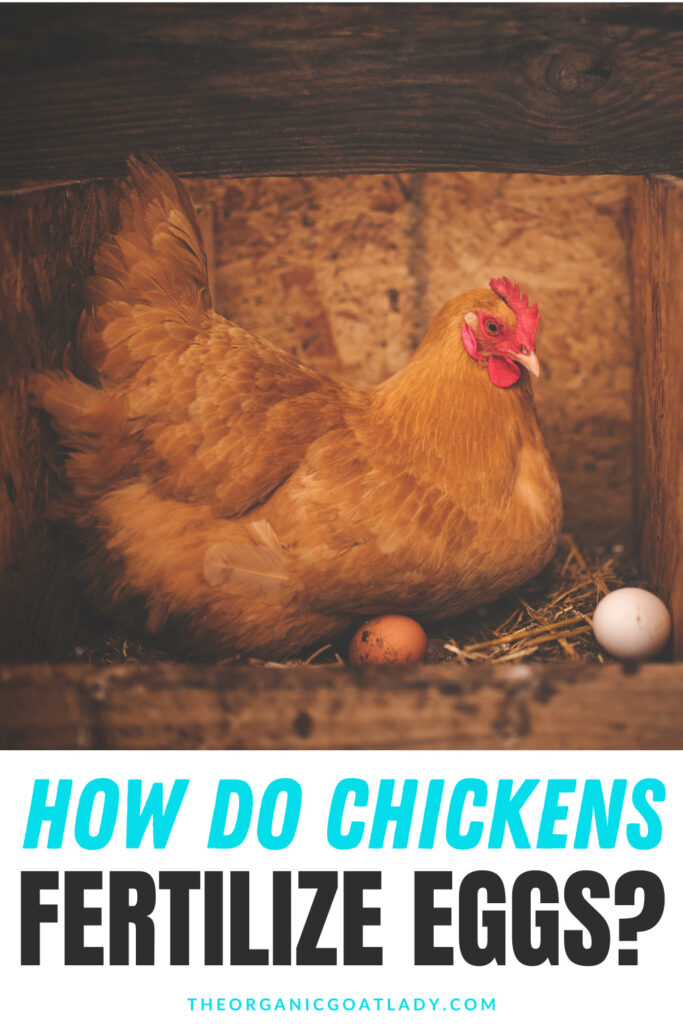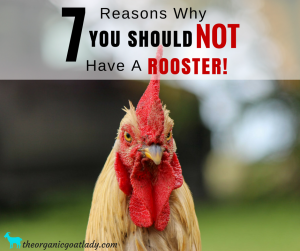Are you wanting to know how do chickens fertilize eggs? Read on to find out how and why you need to have fertilized chicken eggs.
This site contains affiliate links. If you make a purchase using one of these links, I may earn a commission. Please click here for more information about cookies collected and our privacy policy.

How Do Chickens Fertilize Eggs?
Chickens, like many birds, reproduce sexually. Fertilization in chickens occurs internally. Here’s a simplified overview of the chicken reproduction process:
1. Mating Process: Roosters (male chickens) and hens (female chickens) engage in mating behavior. The mature rooster mounts the hen, and during copulation, he transfers sperm to the hen’s reproductive tract.
2. Sperm Storage: Hens have a specialized reproductive system. The rooster’s sperm is stored in an area called the oviduct, where it can remain viable for several days. This allows the hen to lay fertilized eggs over a period of time without needing continuous mating.
3. Egg Formation: The hen’s reproductive system includes the ovaries, where ova (egg cells) are produced. One ovum matures into an egg each day. The mature egg moves into the hen’s oviduct, where it is surrounded by layers of albumen (egg white), membranes, and a protective shell.
4. Fertilization: If the egg encounters the sperm of the rooster in the oviduct, fertilization occurs. The sperm penetrates the ovum, resulting in a fertilized egg. If fertilization does not occur, the egg continues its journey through the oviduct without developing into a chick.
5. Egg Laying: The fully formed and potentially fertilized egg moves through the oviduct and is laid by the hen. The hen’s eggs can be laid whether it is fertilized or not.
If the egg is fertilized, it has the potential to develop into a chick if conditions are right. If the egg is not fertilized, it is still a nutritious food product commonly consumed by humans.
The Difference Between Fertilized and Unfertilized Chicken Eggs
The primary difference between fertilized and unfertilized chicken eggs lies in whether the egg has undergone fertilization by the union of sperm and egg.
1. Fertilized Eggs:
– Formation: Fertilized eggs result from the union of a sperm cell from a rooster with an egg cell (ova) from a hen.
– Development Potential: If conditions are right (such as appropriate temperature and humidity), a fertilized egg has the potential to develop into a chick.
– Visible Indicator: In some cases, a small, circular “blastodisc” or “blastoderm” can be visible on the egg yolk of a fertilized chicken egg, indicating the beginning of embryonic development.
– Common in Backyard Settings: Fertilized eggs are more common in backyard or rural settings where roosters are present with hens.
2. Unfertilized Eggs:
– Formation: infertile eggs are produced when hens lay eggs without having mated with a rooster. In such cases, the egg contains only the genetic material from the hen.
– Development Potential: A non-fertile egg will not develop into a chick, regardless of environmental conditions.
– Visible Indicator: Without fertilization, there is no visible blastodisc or blastoderm on the yolk.
For human consumption, the distinction between fertilized and unfertilized eggs is generally not relevant. Both types of eggs are safe and nutritious to eat.
Fertilized eggs are more commonly found in settings where both hens and roosters are kept together, such as backyard or small-scale poultry farming.
Are Fertilized Chicken Eggs Healthier?
In terms of nutritional content and health benefits, there is generally no significant difference between fertilized and unfertilized chicken eggs when consumed by humans. Both types of eggs provide a rich source of essential nutrients, including protein, vitamins, and minerals.
The nutritional composition of an egg is primarily determined by the hen’s diet and living conditions, rather than whether the egg is fertilized.
Here are some key nutritional aspects of eggs:
1. Protein: Eggs are an excellent source of high-quality protein, regardless of fertilization.
2. Vitamins and Minerals: Eggs contain essential vitamins and minerals, such as vitamin B12, vitamin D, riboflavin, selenium, and others. These nutrients are present in both fertilized and unfertilized eggs.
3. Cholesterol: Eggs do contain cholesterol, but dietary cholesterol has a minimal impact on blood cholesterol levels for most people. The health impact of consuming eggs is generally positive, and they can be part of a balanced diet.
4. Omega-3 Fatty Acids: The nutritional content of eggs can be influenced by the hen’s diet. Eggs from hens that are fed a diet rich in omega-3 fatty acids may have higher levels of these beneficial fats.
The primary factor that determines whether an egg is fertilized is whether the hen has mated with a rooster. The decision to consume fertilized or unfertilized eggs is more relevant to those involved in backyard or small-scale poultry farming, where fertilized eggs have the potential to develop into chicks if incubated under the right conditions.
Why Do Fertilized Eggs Sometimes Have a Spot of Blood in Them?
The presence of blood spots in fertilized eggs is a natural occurrence and is not specific to fertilized eggs; it can also occur in unfertilized eggs. The occurrence of blood spots is generally a result of a blood vessel rupturing in the hen’s reproductive system during the egg formation process.
Here are a few reasons why blood spots may appear:
1. Ovulation: The rupture of a blood vessel in the hen’s ovary during the release of the egg (ovulation) can lead to the release of a small amount of blood along with the egg.
2. Oviduct: As the egg travels through the oviduct, which is the tube where the egg white, membranes, and shell are added, there is a possibility of small blood vessels being damaged, resulting in blood spots.
3. Genetic Factors: Some hens may be genetically predisposed to developing blood spots more frequently.
It’s important to note that the presence of a blood spot in an egg does not indicate that the egg is fertilized. Blood spots are simply a natural occurrence related to the egg-laying process.
They are not harmful to human health and do not affect the taste or nutritional value of the egg. In commercial egg production, eggs with blood spots are usually sorted out during the grading process, and those without visible blood spots are typically sold to consumers.
If you encounter a blood spot in an egg, you can remove it if you find it unappealing, but the egg is still safe to eat. Cooking the egg will also denature the proteins and make the blood spot less noticeable.
How to Tell if a Chicken Egg is Fertilized or Not
Determining whether a chicken egg is fertilized or not can be challenging without specialized equipment. However, there are a few methods that people may use, though none are foolproof.
Here are some common approaches:
1. Candling:
– Equipment: Candling involves shining a bright light through the egg shell in a dark room, allowing you to see the internal contents.
– Process: Hold the egg up to a bright light source, such as a flashlight or a specialized candling device, and observe the contents.
– Indicators: A fertilized egg may show some early signs of development, such as the presence of veins, a small embryo, or a noticeable spot (blastodisc or blastoderm) on the yolk. Unfertilized eggs typically appear clear.
– Timing: Candling is most effective around 7-10 days after incubation when embryonic development becomes more visible.
2. Incubation:
– Equipment: If you have access to an incubator, you can incubate the egg for a few days.
– Observation: After a few days of incubation, you might see signs of embryonic development, such as veining or movement, when candling the egg.
– Limitation: This method is more practical for those involved in hatching eggs rather than those simply trying to determine fertilization.
3. Cracking the Egg:
– Visual Inspection: Some people believe that a fertilized egg will have a small white spot on the yolk or a visible bullseye pattern.
– Limitation: This method involves breaking the egg, so it is not suitable for those looking to keep the egg intact.
It’s important to note that none of these methods are foolproof, and there is no guaranteed way to determine fertilization without specialized equipment or procedures.
How Long Does a Hen Need to Sit on a Fertilized Egg to Make a Baby Chick?
The process of incubating chicken eggs, whether done by a hen or in an artificial incubator, generally takes about 21 days from the start of consistent incubation.
Here’s a breakdown of the incubation process:
1. Incubation Period: The incubation period for chicken eggs is approximately 21 days from the start of incubation. During this time, the eggs need to be kept at the appropriate temperature and humidity for proper embryonic development.
2. Consistent Incubation: The 21-day period begins when the hen or incubator starts consistently maintaining the appropriate conditions for the eggs. It’s essential for the eggs to experience continuous warmth and humidity to allow the development of the embryo.
3. Turning Eggs: In the natural setting, a broody hen will turn and move the eggs regularly to ensure even heat distribution and proper development. If using an artificial incubator, turning the eggs regularly is typically part of the process to mimic the hen’s behavior.
4. Candling: Around the 7-10 day mark, candling can be used to check for signs of embryonic development. Candling involves shining a bright light through the egg in a dark room to observe the internal contents.
5. Hatching: After approximately 21 days, the chicks will start to hatch from the eggs. The hatching process may take a day or two, and it’s essential not to disturb the eggs during this period.
It’s worth noting that the incubation period can vary slightly depending on factors such as temperature, humidity, and the specific breed of chicken. During incubation, it’s crucial to maintain stable and appropriate conditions to ensure the health and development of the chicks inside the eggs.
Are Supermarket Eggs Fertilized Eggs?
No, in general, the eggs that you find in a grocery store for human consumption are not fertilized. Commercial egg-laying facilities typically do not keep roosters with the laying hens. Since fertilization requires the presence of a rooster to provide sperm, the eggs laid by hens in commercial settings are usually unfertilized.
The absence of roosters in commercial egg production ensures that the eggs do not have the potential to develop into chicks, even if they are kept under conditions suitable for incubation. Unfertilized eggs are still nutritious and safe to eat, and the vast majority of eggs available for purchase in supermarkets fall into this category.
If you are purchasing eggs for eating purposes, there is no need to worry about finding fertilized eggs in the carton. However, if you are interested in hatching eggs or raising chicks, you would need to source fertilized eggs from a different, more specialized supplier or consider keeping your own roosters with laying hens.
Should You Own a Rooster or Just Hens?
There are lots of pros and cons when it comes to roosters!


